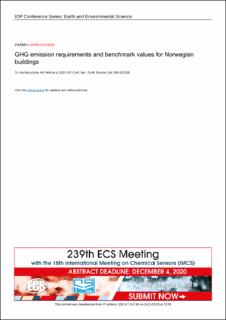| dc.contributor.author | Wiik, Marianne Rose Kjendseth | |
| dc.contributor.author | Selvig, Eivind | |
| dc.contributor.author | Fuglseth, Mie Sparby | |
| dc.contributor.author | Resch, Eirik | |
| dc.contributor.author | Lausselet, Carine | |
| dc.contributor.author | Andresen, Inger | |
| dc.contributor.author | Brattebø, Helge | |
| dc.contributor.author | Hahn, Ulla | |
| dc.date.accessioned | 2020-11-24T15:39:23Z | |
| dc.date.available | 2020-11-24T15:39:23Z | |
| dc.date.created | 2020-11-02T18:46:01Z | |
| dc.date.issued | 2020 | |
| dc.identifier.issn | 1755-1307 | |
| dc.identifier.uri | https://hdl.handle.net/11250/2689414 | |
| dc.description.abstract | As a response to the Paris agreement, Norway is committed to reducing greenhouse gas (GHG) emissions by 50 percent by 2030. Highly energy-efficient buildings have a greater proportion of embodied GHG emissions from material use (55-87%) compared to operational emissions. A new national standard, NS3720:2018 a methodology for greenhouse gas emission calculations for buildings, has harmonised the life cycle assessment (LCA) calculation of environmental impacts arising from Norwegian buildings and has led to an increase in LCAs. This paper aims to collect life cycle GHG emission data on Norwegian building case studies to help form recommendations for national GHG emission requirements and benchmark values that can be used by the Research centre for zero emission neighbourhoods in smart cities (FME ZEN), Futurebuilt and in Norwegian building codes (TEK). To do this, a statistical analysis of a reference sample is carried out to provide bottom-up derived reference values. Empirical life cycle GHG emission data results are collected from Norwegian building case studies in the reference, design and as-built project phases, sampled from Norwegian programmes and research centres such as Futurebuilt, Framtidens Byer, ZEB and ZEN. Altogether 133 Norwegian building cases have been gathered from 2009-2020, covering 1,023,738m2 of heated floor area for 49,360 building users. A functional unit of '1m2 of heated floor area over a building lifetime of 60 years is used. The results show an interquartile range of 240-492 kgCO2eq/m2 or 4-8.2 kgCO2eq/m2/yr, a median of 396 kgCO2eq/m2 or 6.6 kgCO2eq/m2/yr and a mean of 324 kgCO2eq/m2 or 5,4 kgCO2eq/m2/yr for all building typologies in the as-built phase. These results can be used to form initial indications for GHG emission requirements and benchmark values in Norway. | en_US |
| dc.language.iso | eng | en_US |
| dc.relation.ispartof | BEYOND 2020 – World Sustainable Built Environment conference | |
| dc.rights | CC BY 3.0 | * |
| dc.rights.uri | https://creativecommons.org/licenses/by/3.0/ | * |
| dc.title | GHG emission requirements and benchmark values in Norwegian building codes | en_US |
| dc.type | Peer reviewed | en_US |
| dc.type | Journal article | en_US |
| dc.description.version | publishedVersion | en_US |
| dc.rights.holder | © 2020 The authors | en_US |
| dc.source.volume | 588 | en_US |
| dc.source.journal | IOP Conference Series: Earth and Environmental Science (EES) | en_US |
| dc.identifier.doi | 10.1088/1755-1315/588/2/022005 | |
| dc.identifier.cristin | 1844295 | |
| dc.relation.project | Norges forskningsråd: 257660 | en_US |
| cristin.ispublished | true | |
| cristin.fulltext | original | |
| cristin.qualitycode | 1 | |

